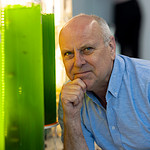Creating circular farms with seagriculture
- Research project


Dutch dairy farms face a difficult task. For instance, manure from cattle farms contributes to the nitrogen problem, and most cattle feed is produced from soy from South America. For this soy, forests which play a vital role in the local ecosystem are cleared. This feasibility study explores a design for a circular dairy farm, where the farmer can produce their own cattle feed while getting rid of their manure. This cattle feed comes from seaweed and grass clover that farmers can grow themselves with seagriculture.
Seaweed farming is the cultivation of seaweed on land by means of basins. By placing these basins on farms, farmers can grow their own seaweed. This project uses the seaweed species Ulva lactuca. This seaweed species has a protein percentage of 22%. This is supplemented with grass clover to produce healthy and protein-rich feed.
Ulva seaweed culture uses nitrogen as nutrition. Thus, manure from a livestock farm can be used to grow seaweed. For this, it must first be fermented into biogas.
The result is that a farmer with a dairy farm with 100 cows can drastically reduce his/her nitrogen emissions, while growing protein locally for cattle feed. This farmer can be fully self-sufficient in terms of feed and fully circular with nitrogen on 45 hectares of seaweed and clover cultivation. In other words: a dairy farm without soy, without artificial fertilisers, without manure surpluses, with room for new nature and fully circular!

Lector Plant Production & Processing
Nijenborgh 6, 9746 AG Groningen

Want to know more about the professorship Plant Production and Processing?
Read moreHow satisfied are you with the information on this page?